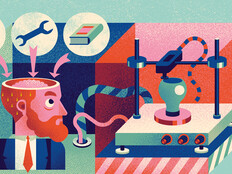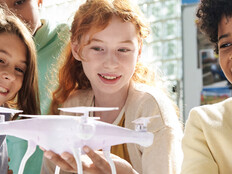3D Printing Brings New Definition to Hands-On Learning
Imagine you’re teaching a lesson on the Statue of Liberty. Now, imagine you can walk over to your computer, hit a button, and print out a fully formed, to-scale 3D replica of Lady Liberty for students to share and pass around the class — all in a matter of minutes.
That’s the idea behind rapidly evolving 3D printing technology. Advocates say the concept, which critics have shrugged off as an expensive novelty — good for shaping toys and knickknacks on the level of plastic army men — could potentially enable a new generation of makers who will be both designer and manufacturer of their own products.
How would it work in schools?
The technology is already making inroads in education. The machines used to be cost-prohibitive — even the cheapest models could set a school back several thousand dollars, and that’s not including the software — but the price point in recent years has dropped dramatically, with some machines available for as little as $500, or less than the cost of a desktop computer. (Though most models are still a bit more expensive.)
With prices on their way down, many schools have considered investing in the technology. Atascocita High School in Texas recently purchased a 3D printer and design software. Technology teacher Russell Stilley told The Tribune, a local paper, that the technology would give students a better feel for the skills required in design and manufacturing careers.
The STEM Academy, a national nonprofit that emphasizes the importance of science, technology, engineering and mathematics in K–12 schools, recently partnered with 3D printer manufacturer Stratasys to use its devices in certain education training programs.
How does it work, exactly?
At its most basic level, 3D printing requires three items:
- (1) software to design your product,
- (2) a 3D printer to turn your designs into tangible models and
- (3) materials to form and create those models (usually plastic or rubber).
Students and teachers can use traditional CAD modeling software or another program built specifically for 3D printing, depending on hardware and software. Once the model is designed using the software program, it is saved and transmitted to the 3D printer, which resembles an oversized microwave. The designer then must choose what materials he or she wants to use — e.g., plastic or rubber (higher-priced machines incorporate a wider mix of materials) — and wait for the printer to work. Want to learn more? The tech site Mashable recently published an excellent infographic that explains the process.
So, what’s the upshot?
It’s still largely unclear how long it will take for 3D printing to achieve widespread adoption in K–12 schools. The most recent Horizon report for K–12 education, a collaboration between EDUCAUSE and the New Media Consortium, said the technology isn’t likely to be mainstream for at least another four years.
Still, supporters of the technology are excited by the possibilities.
“I strongly believe that 3D printing will not only prepare students for the future in technology, but it will also motivate students to use creativity to design products,” AHS’s Stilley told The Tribune.
What’s your take? Is 3D printing set to spark a revolution in K–12 education? Or is it a passing fad with some pretty cool, albeit largely futuristic, applications? Check out the video below — and tell us in the Comments.








